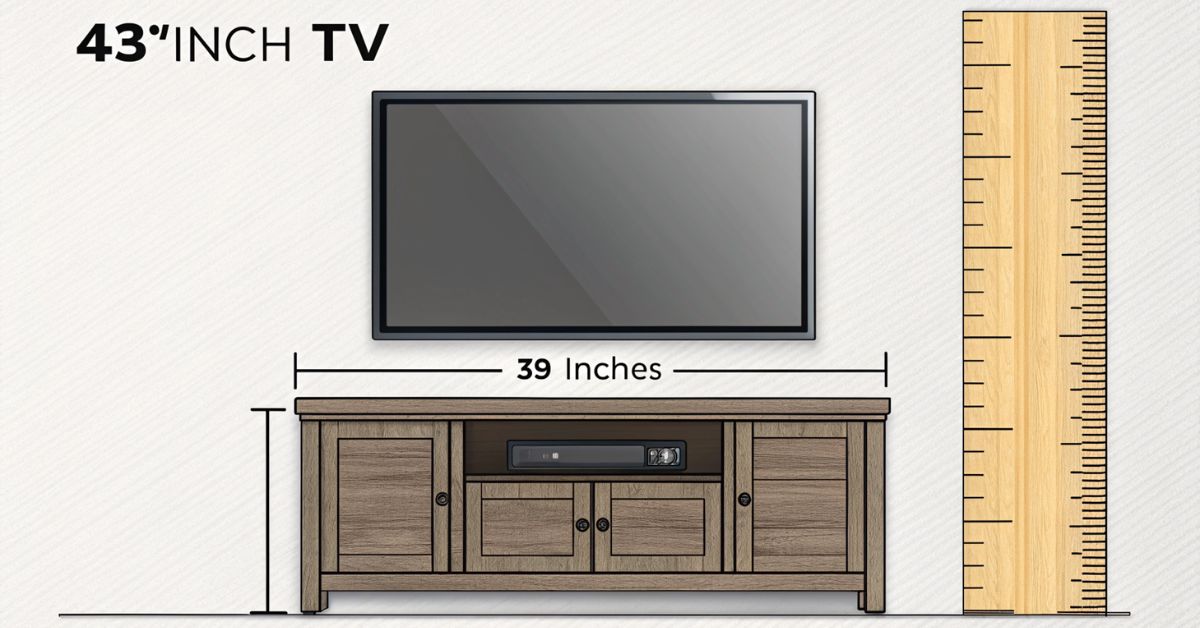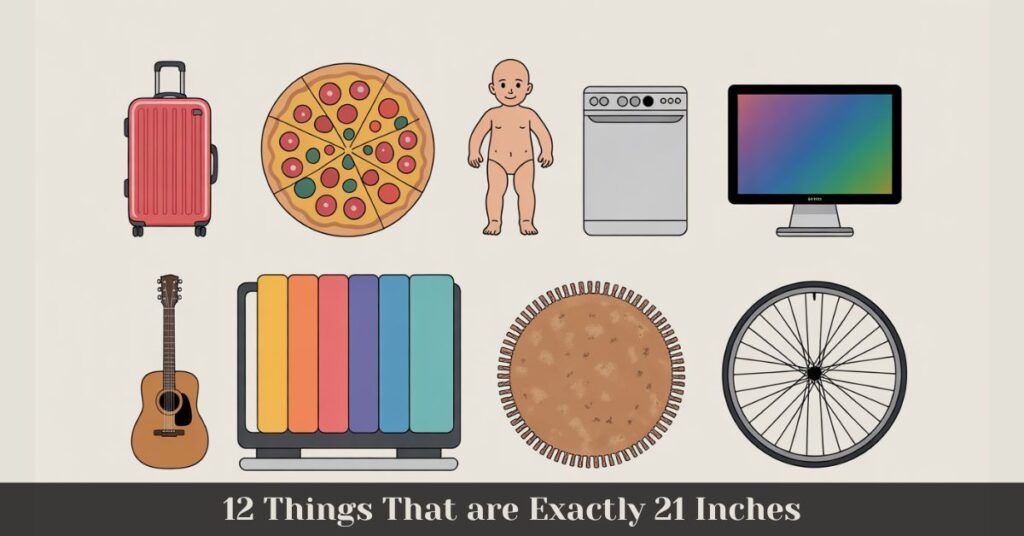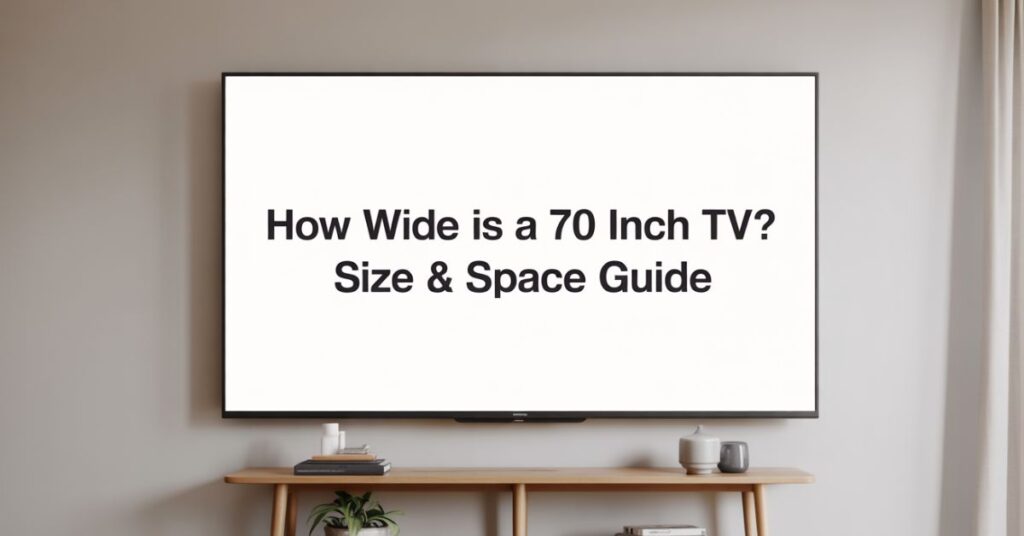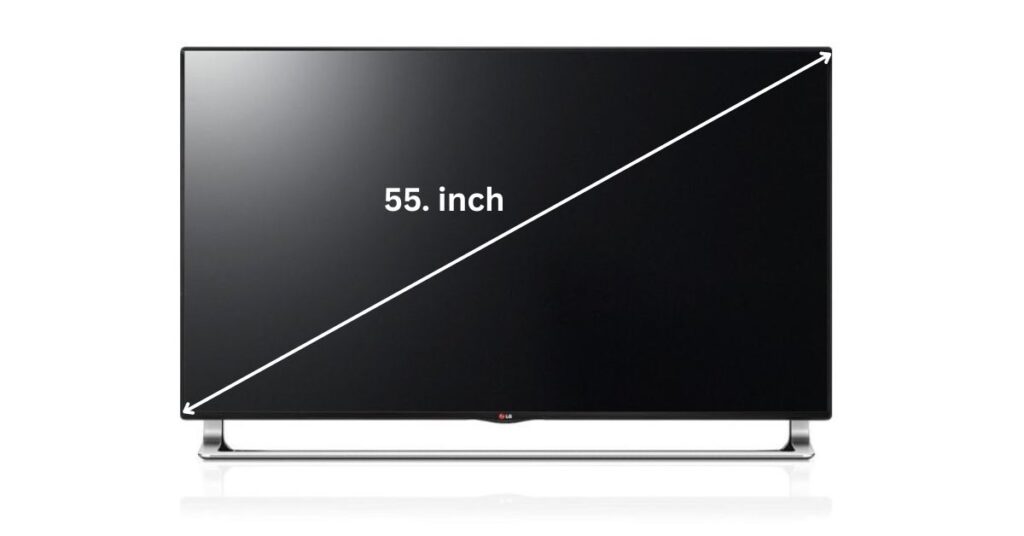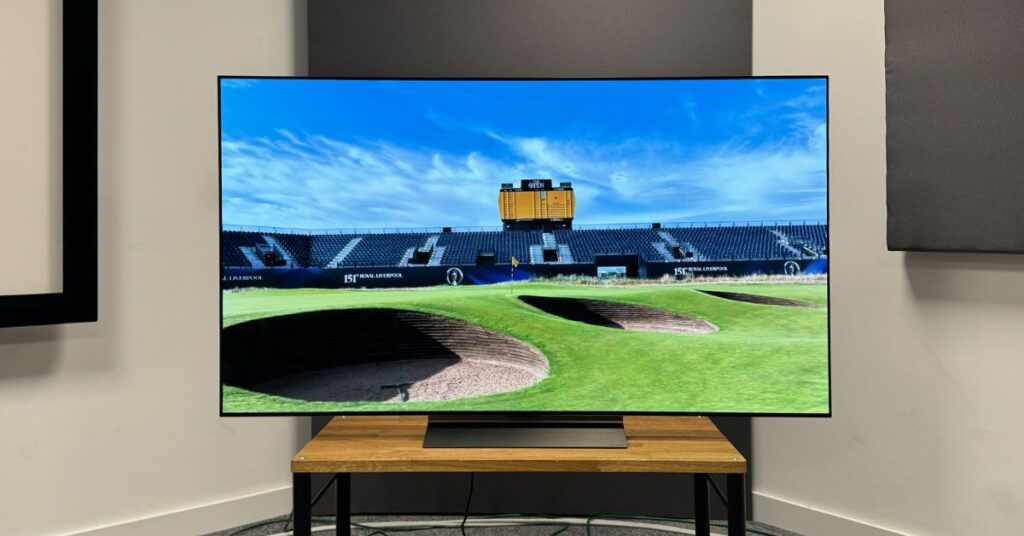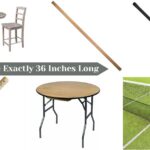You’ve found the perfect 43-inch TV, but measuring diagonally doesn’t tell you if it’ll actually fit your entertainment center.
Most 43-inch TVs measure 37.5 to 38.1 inches wide – significantly different from that 43-inch diagonal measurement. Let’s decode the real dimensions you need to know before making your purchase.
TV Measurements
📏 Understanding TV Measurements: Diagonal vs. Actual Width
🔍 Brand Width Comparison Chart
🏠 Optimal Room Size Guide
📺 TV Stand Width Requirements
🎨 Samsung Frame TV Width Breakdown
📐 Essential Measurement Checklist
❓ Quick Answer Reference
✅ Final Decision Checklist
Why TVs Are Measured Diagonally
Television manufacturers measure screens diagonally because it maximizes the advertised size number. This tradition started with cathode-ray tube TVs in the 1950s.
The diagonal measurement includes only the viewable screen area, not the bezels, stands, or frame. This creates confusion when you’re trying to fit a TV into specific furniture dimensions.
Modern flat-panel displays continue this practice, even though the actual footprint matters more for placement planning.
The Anatomy of TV Dimensions
Every TV has three critical measurements: width, height, and depth. The width determines if your TV fits your stand or wall space.
Bezel thickness varies dramatically between brands and models. Ultra-thin bezels on premium models can save you nearly an inch in total width.
Stand dimensions add extra width and often extend beyond the screen edges. Wall-mounted TVs eliminate this concern entirely.
Brand Comparisons
Standard Width Ranges
Most 43-inch TVs without stands measure between 37.5 to 38.1 inches wide. This represents the actual screen plus minimal bezels.
With stands attached, expect 37.8 to 39.2 inches total width. Stand designs vary significantly between manufacturers and price points.
The standard 16:9 aspect ratio ensures consistent width calculations across brands. Ultra-wide formats remain rare in this size category.
Popular Brand Comparisons
Samsung 43-inch models typically measure 37.8 inches wide without stands. Their Frame TV series adds decorative borders, reaching up to 39.2 inches.
LG 43-inch TVs measure approximately 37.9 inches wide for most LED models. Their OLED variants can be slightly narrower due to different panel construction.
Sony 43-inch displays range from 37.6 to 38.0 inches wide, depending on the series. Premium models often feature thinner profiles.
TCL and Hisense budget models typically measure 38.0 to 38.1 inches wide, with slightly thicker bezels to reduce manufacturing costs.
Factors Affecting Width Variations
Bezel evolution continues shrinking TV footprints. Modern TVs have bezels under 0.5 inches thick, compared to 2+ inches on older models.
Smart TV integration doesn’t significantly impact width, as processing components fit within the existing frame structure.
Manufacturing tolerances can create 0.1-0.2 inch variations between identical model numbers from different production runs.
Room Size Requirements
Optimal Viewing Distance Calculations
THX recommendations suggest sitting 5.4 to 8.1 feet from a 43-inch screen for optimal viewing comfort and detail perception.
SMPTE guidelines recommend slightly closer distances for movie content – approximately 4.9 to 6.5 feet for cinematic experiences.
Eye strain prevention becomes critical at distances under 5 feet. Your eyes work harder to focus on nearby large screens.
Room Layout Considerations
Small apartments benefit from corner placement or swivel mounts that accommodate multiple seating arrangements.
Medium-sized living rooms (12×15 feet) easily accommodate 43-inch TVs with flexible furniture arrangements.
Bedroom installations work well with wall mounting at proper heights to prevent neck strain during extended viewing.
Corner placement strategies can save significant floor space while maintaining good viewing angles for most seating positions.
Furniture Arrangement Impact
Seating distance planning should account for reclining chairs and sofas that move viewers closer during use.
Neck strain prevention requires mounting TVs at eye level when seated. Too high or low creates discomfort quickly.
Multiple viewing angles matter in open floor plans where people view from kitchens, dining areas, and living spaces.
TV Stand and Mounting Requirements
TV Stand Width Guidelines
Your TV stand should be 40-45 inches wide minimum to provide adequate support and visual balance with a 43-inch screen.
Overhang safety becomes dangerous when TV edges extend beyond stand edges. Wind, bumps, or vibrations can topple precariously balanced TVs.
Weight distribution requires sturdy construction. A 43-inch TV typically weighs 25-35 pounds, demanding solid support structures.
Style matching benefits from stands 6-12 inches wider than the TV for proportional aesthetics and extra storage space.
Wall Mount Specifications
VESA mounting patterns for 43-inch TVs typically use 200x200mm or 300x300mm hole spacing standards.
Wall stud requirements demand mounting into at least two 16-inch centered studs for safety and stability.
Cable management solutions benefit from in-wall routing or decorative covers to maintain clean appearances.
Height positioning should center screens at seated eye level – typically 42-48 inches from floor to screen center.
Furniture Compatibility
Entertainment centers need 40+ inch openings to accommodate most 43-inch TVs with adequate ventilation space.
Media console requirements include depth for cable connections and width for visual balance with the screen size.
Built-in cabinet modifications may require enlarging openings or adjusting shelving to fit modern TV dimensions.
Specific Model Deep Dive
Unique Design Elements
The Samsung Frame TV measures 37.8 inches wide for the base display panel, identical to standard Samsung 43-inch models.
Art Mode bezels add decorative frames that increase total width to 38.5-39.2 inches, depending on frame style selection.
One Connect Box placement requires separate space for the external connection hub, typically positioned in nearby cabinets.
Installation Differences
Flush wall mounting requires Samsung’s proprietary No Gap Wall Mount for the signature floating artwork appearance.
No Gap Wall Mount requirements demand precise measurements and professional installation for optimal results.
Ambient light sensors need unobstructed positioning to automatically adjust screen brightness throughout the day.
Practical Measurement Tips
Before You Buy Checklist
Use a measuring tape to check your intended TV location, including height, width, and depth clearances.
Doorway and stairway clearance matters for delivery. Most 43-inch TVs measure 39-41 inches diagonally in packaging.
Delivery pathway planning prevents costly returns when TVs can’t reach their intended rooms through narrow passages.
Return policy considerations vary by retailer. Understand size-related return restrictions before purchasing.
Common Measurement Mistakes
Packaging dimensions add 4-6 inches to TV measurements for protective materials and shipping boxes.
Ignoring cable connection space behind wall-mounted TVs requires 3-4 inches clearance for HDMI and power cables.
Stand assembly requirements need floor space during setup, even if you plan wall mounting later.
FAQ’s
How wide are 43-inch TVs exactly?
Most 43-inch TVs measure 37.5 to 38.1 inches wide without stands. With stands, expect 37.8 to 39.2 inches total width. Samsung models typically measure 37.8 inches, while LG models reach 37.9 inches wide.
What is the width of a 43-inch model without the stand?
Without stands, 43-inch TVs measure 37.5 to 38.1 inches wide. Premium models with ultra-thin bezels measure closer to 37.5 inches, while budget models reach 38.1 inches due to thicker frames.
How big should a room be for a 43-inch TV?
Your room should allow 5.4 to 8.1 feet viewing distance. A 10×12 foot room works perfectly, while smaller 8×10 foot spaces accommodate 43-inch TVs with careful placement.
What is the actual width of a 42-inch TV?
42-inch TVs measure 36.6 to 37.1 inches wide without stands – approximately 0.9 inches narrower than 43-inch models due to the proportional diagonal measurement difference.
How wide does a TV stand need to be for a 43-inch TV?
TV stands should be 40-45 inches wide minimum for safety and aesthetics. Wider stands (48+ inches) provide better stability, storage space, and visual balance.
How wide is a 43-inch Samsung Frame TV?
Samsung Frame TVs measure 37.8 inches wide for the base display. With decorative frames attached, total width reaches 38.5-39.2 inches, depending on frame style selection.
Do curved 43-inch TVs have different width measurements?
Curved 43-inch TVs measure 37.5-38.0 inches wide at the widest points, similar to flat panels. The curve adds minimal width but affects depth requirements.
How much extra space should I leave on each side of my 43-inch TV?
Leave 2-3 inches minimum on each side for ventilation and visual balance. This creates 42-44 inch total space requirements for optimal placement.
Will a 43-inch TV fit through a standard doorway?
Yes, 43-inch TVs easily fit through 32-36 inch doorways when carried at angles. Packaging may require box removal for tighter spaces.
What’s the difference in width between OLED and LED 43-inch TVs?
OLED panels can be 0.1-0.2 inches narrower than LED models due to different backlighting requirements and thinner overall construction.
Do smart TV features affect overall width?
Smart TV capabilities don’t impact width. All processing components fit within standard frame dimensions without adding external bulk.
How do I measure for a recessed wall mount with a 43-inch TV?
Recessed installations need 39-40 inch wide openings to accommodate TV width plus mounting hardware and cable access space.
Expert Buying Recommendations
Best 43-Inch TVs for Small Spaces
TCL 4-Series offers excellent value with 38.0-inch width and comprehensive smart features under $300.
Samsung Crystal UHD provides premium picture quality in a 37.8-inch wide package with thin bezels.
LG C3 OLED delivers flagship performance with ultra-thin 37.6-inch width for space-conscious buyers.
Future-Proofing Considerations
4K resolution remains the sweet spot for 43-inch viewing distances. 8K content provides minimal benefits at typical viewing ranges.
Gaming features like 120Hz refresh rates and VRR support matter for PlayStation 5 and Xbox Series X owners.
Smart platform longevity favors Google TV and Roku TV systems with consistent update support.
Conclusion: Making the Perfect Fit
43-inch TVs measure 37.5-38.1 inches wide without stands, requiring 40-45 inch furniture or wall spaces for proper installation. Always measure your space carefully and account for cable clearances before purchasing. Consider your room size, viewing distance, and furniture compatibility to ensure your new TV enhances rather than overwhelms your living space.

Welcome to Swiftnis.com! I manage this site to provide accurate and easy-to-understand measurement guides. My goal is to make measurements simple for everyone. Whether you need Conversions, Tools, or Tips, I’m here to help. Enjoy exploring and measuring with confidence!
